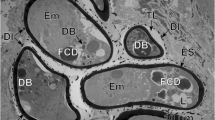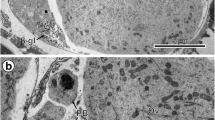Summary
The embryo ofOncopeltus fasciatus forms a typical secondary dorsal organ (SDO). It develops after katatrepsis from the contracting serosa, the cells of which decrease in diameter but increase considerably in height. After 66 h, the SDO represents a protrusion of the serosal epithelium above the head and is then reduced to a disc-shaped formation, which sinks into the yolk, where it disintegrates after 80 h.
During its typical expression, between 66 and 78 h, the SDO shows a zonal arrangement of its cell organelles. The nucleus, which is located in the basal cell region, has a very irregular outline and includes several nucleoli and globular inclusion bodies. Rough and smooth ER are well developed around the nucleus and suggest the involvement of the organ in protein secretion as well as in lipid metabolism. Electron-lucent vacuoles and electron-dense granules, sometimes enclosed in the vacuoles, accumulate in the apical cell region, and are obviously extruded into the peripheral (extraembryonic) space. The formation of intercellular clefts and delicate cytoplasmic extensions facing the yolk and microvilli facing the periphery evidence a transporting function of the epithelium. Blisters intercalated in extended junctional complexes between apical cell regions point to the transport of solutes.
Because of the similarities of the processes observed in the SDO and in Malpighian tubules of larvae, an excretory function of the SDO is suggested. Final products of yolk and embryo are apparently transported to the extraembryonic space, where they accumulate during embryogenesis.
Phylogeny, relationship, and function of the different embryonic glands in Arthropoda (primary and secondary DO and pleuropodia) are discussed.
Similar content being viewed by others
References
Butt, F.H.: Embryology of the milkweed bugOncopeltus fasciatus. Cornell Univ. Agr. Exp. Sta., Mem.283, 1–43 (1949)
Cobben, R.H.: Evolutionary trends in Heteroptera. I. Egg, architecture of shell, gross embryology and eclosion. Wageningen (Netherlands): Centre for Agricultural Publication and Documentation 1968
DiBona, D.R., Civan, M.M.: Intercellular pathway for water and solute movement across the toad bladder. In: Transport mechanisms in epithelia (H.H. Ussing, N.A. Thorn, eds.), pp. 161–172. Proceedings of the Alfred Benzon Symposium V. Copenhagen: Munksgaard 1973
Dorn, A.: Die endokrinen Drüsen im Embryo vonOncopeltus fasciatus Dallas (Insecta, Heteroptera). Morphogenese, Funktionsaufnahme, Beeinflussung des Gewebewachstums und Beziehungen zu den embryonalen Häutungen. Z. Morphol. Tiere71, 52–104 (1972)
Dorn, A.: Ultrastructure of embryonic envelopes and integument ofOncopeltus fasciatus Dallas (Insecta, Heteroptera). I. Chorion, Amnion, Serosa, Integument. Zoomorph.85, 111–131 (1976)
Gough, L.H.: The development ofAdmetus pumilio Koch, a contribution to the embryology of the pedipalps. A.J. Micr. Sci.45, 595–630 (1902)
Heymons, R.: Die Embryonalentwicklung von Dermapteren und Orthopteren unter besonderer Berücksichtigung der Keimblätterbildung. Jena: Gustav Fischer 1895
Heymons, R.: Über die Organisation und Entwicklung vonBacillus rossi. Sitzungsber. Preuß. Akad. Wissenschaften Berlin, physik.-math. Kl. Jg.1897, 583–631
Heymons, R.: Die Entwicklungsgeschichte der Scolopendra. Zoologica13, 1–244 (1901)
Hirschler, J.: Die Embryonalentwicklung vonDonacia crassipes L. Z. Wiss. Zool.92, 627–744 (1909)
Johannsen, O.A., Butt, T.H.: Embryology of insects and myriapods. New York: McGraw-Hill 1941
Jura, C.: The significance and function of the primary dorsal organ in embryonic development ofTetrodontophora bielanensis (Waga) Collembola. Acta Biol. Crac., Ser. Zool.10, 301–311 (1967)
Jura, C.: Development of apterygote insects. In: Developmental systems: Insects, Vol. 1, pp. 49–94 (S.J. Counce, C.H. Waddington, eds.). London-New York: Academic Press 1972
Louvet, J.-P.: L'ultrastructure du pleuropode et son ontogenèse, chez l'embryon du phasmeCarausius morosus Br. I. Etude du pleuropode de l'embryon agé. Ann. Sci. Natl. Zool. (Paris)15, 525–594 (1973)
Louvet, J.-P.: Premières observations sur l'ultrastructure du pleuropode chez le criquet migrateur. C.R. Acad. Sci. (Paris)D 280, 1301–1304 (1975)
Noirot, C., Noirot-Timothée, C.: Ultrastructure du proctodeum chez le thysanureLepis modes inquilinus Newman (=Thermobia domestica Packard). I. La région antérieure (ileon et rectum). J. Ultrastruct. Res.37, 119–137 (1971)
Osche, G.: Die systematische Stellung und Phylogenie der Pentastomida, embryologische und vergleichend-anatomische Studien anReighardia sternae. Z. Morphol. Ökol. Tiere52, 487–596 (1963)
Oschman, J.L., Wall, B.J., Gupta, B.L.: Cellular basis of water transport. In: Transport at cellular level. Symp. Soc. Exp. Biol.28, pp. 305–350. Cambridge: University Press 1974
Philiptschenko, J.: Beiträge zur Kenntnis der Apterygoten. III. Die Embryonalentwicklung vonIsotoma cinerea, Z. Wiss. Zool.103, 519–660 (1912)
Polivanova, E.N.: Excretory system and excretion processes in the embryonic development of bugs Pentatomoidea. Ž. Obšč. Biol.26, 700–710 (1965)
Roemhild, G.: Mechanisms of blastokinesis in insect embryos. In: Aspects of the embryonic physiology of insects (S. N. Visscher, ed.). In press
Slifer, E.H.: The origin and fate of the membranes surrounding the grasshopper egg; together with some experiments on the source of the hatching enzyme. Q. J. Micr. Sci.79, 493–506 (1937)
Slifer, E.H.: A cytological study of the pleuropodia ofMelanoplus differentialis (Orthoptera, Acrididae) which furnishes new evidence that they produce the hatching enzyme. J. Morphol.63, 181–206 (1938)
Sohal, R.S.: Fine structure of the Malpighian tubules in the housefly,Musca domestica. Tissue Cell6, 719–728 (1974)
Strindberg, H.: Embryologische Studien an Insekten. Z. Wiss. Zool.106, 1–227 (1913)
Tamarelle, M.: Premières observations ultrastructurales sur l'organe dorsal de l'embryon, chez le collemb'oleCeratophysella bengtssoni. C.R. Acad. Sci. (Paris)D 276, 2831–2834(1973)
Tamarelle, M.: Nouvelles observations sur l'ultrastructure de l'organe dorsal des collemboles. Mise en évidence d'un type de différenciation ≪en cocarde≫, chezProisotoma minute. C.R. Acad. Sci. (Paris)D280, 897–899 (1975)
Tiegs, O.W.: The embryology and affinities of the Symphyla, based on a study ofHanseniella agilis. Q. J. Micr. Sci.82, 1–225 (1941)
Tiegs, O.W.: The ‘dorsal-organ’ of collembolan embryos. Q. J. Micr. Sci.83, 153–169 (1942)
Tiegs, O.W.: The ‘dorsal-organ’ of the embryo ofCampodea. Q. J. Micr. Sci.84, 35–47 (1944)
Wessing, A., Eichelberg, D.: Elektronenoptische Untersuchungen an den Nierentubuli (Malpighische Gefäße) vonDrosophila melanogaster. I. Regionale Gliederung der Tubuli. Z. Zellforsch.101, 285–322 (1969)
Weygoldt, P.: Beitrag zur Kenntnis der Ontogenie der Dekapoden: Embryologische Untersuchungen anPalaemonetes varians. Zool. Jb. Abt. Anat. Ontog.79, 223–270 (1961)
Wheeler, W.M.: A contribution to insect embryology. J. Morphol.8, 1–160 (1893)
Willey, A.: Trophoblast and serosa. A contribution of insects. Q. J. Micr. Sci.41, 589–609 (1899)
Zissler, D., Weygoldt, P.: Feinstruktur der embryonalen Lateralorgane der GeißelspinneTarantula marginemaculata C.L. Koch (Amblypygi, Arachnida). Cytobiologie11, 466–479 (1975)
Author information
Authors and Affiliations
Additional information
Dedicated to Prof. Dr. B. Scharrer on the occasion of her birthday
Supported by the Deutsche Forschungsgemeinschaft
I am grateful to Miss K. Schmidtke and Mrs. M. Ullmann for technical assistance
Rights and permissions
About this article
Cite this article
Dorn, A. Ultrastructure of embryonic envelopes and integument ofOncopeltus fasciatus dallas (Insecta, Heteroptera). Zoomorphologie 89, 57–72 (1978). https://doi.org/10.1007/BF00993782
Received:
Issue Date:
DOI: https://doi.org/10.1007/BF00993782




